Navdeep Jaitly
LaDiR: Latent Diffusion Enhances LLMs for Text Reasoning
Oct 06, 2025



Abstract:Large Language Models (LLMs) demonstrate their reasoning ability through chain-of-thought (CoT) generation. However, LLM's autoregressive decoding may limit the ability to revisit and refine earlier tokens in a holistic manner, which can also lead to inefficient exploration for diverse solutions. In this paper, we propose LaDiR (Latent Diffusion Reasoner), a novel reasoning framework that unifies the expressiveness of continuous latent representation with the iterative refinement capabilities of latent diffusion models for an existing LLM. We first construct a structured latent reasoning space using a Variational Autoencoder (VAE) that encodes text reasoning steps into blocks of thought tokens, preserving semantic information and interpretability while offering compact but expressive representations. Subsequently, we utilize a latent diffusion model that learns to denoise a block of latent thought tokens with a blockwise bidirectional attention mask, enabling longer horizon and iterative refinement with adaptive test-time compute. This design allows efficient parallel generation of diverse reasoning trajectories, allowing the model to plan and revise the reasoning process holistically. We conduct evaluations on a suite of mathematical reasoning and planning benchmarks. Empirical results show that LaDiR consistently improves accuracy, diversity, and interpretability over existing autoregressive, diffusion-based, and latent reasoning methods, revealing a new paradigm for text reasoning with latent diffusion.
DiffuCoder: Understanding and Improving Masked Diffusion Models for Code Generation
Jun 26, 2025Abstract:Diffusion large language models (dLLMs) are compelling alternatives to autoregressive (AR) models because their denoising models operate over the entire sequence. The global planning and iterative refinement features of dLLMs are particularly useful for code generation. However, current training and inference mechanisms for dLLMs in coding are still under-explored. To demystify the decoding behavior of dLLMs and unlock their potential for coding, we systematically investigate their denoising processes and reinforcement learning (RL) methods. We train a 7B dLLM, \textbf{DiffuCoder}, on 130B tokens of code. Using this model as a testbed, we analyze its decoding behavior, revealing how it differs from that of AR models: (1) dLLMs can decide how causal their generation should be without relying on semi-AR decoding, and (2) increasing the sampling temperature diversifies not only token choices but also their generation order. This diversity creates a rich search space for RL rollouts. For RL training, to reduce the variance of token log-likelihood estimates and maintain training efficiency, we propose \textbf{coupled-GRPO}, a novel sampling scheme that constructs complementary mask noise for completions used in training. In our experiments, coupled-GRPO significantly improves DiffuCoder's performance on code generation benchmarks (+4.4\% on EvalPlus) and reduces reliance on AR bias during decoding. Our work provides deeper insight into the machinery of dLLM generation and offers an effective, diffusion-native RL training framework. https://github.com/apple/ml-diffucoder.
SpeakStream: Streaming Text-to-Speech with Interleaved Data
May 25, 2025Abstract:The latency bottleneck of traditional text-to-speech (TTS) systems fundamentally hinders the potential of streaming large language models (LLMs) in conversational AI. These TTS systems, typically trained and inferenced on complete utterances, introduce unacceptable delays, even with optimized inference speeds, when coupled with streaming LLM outputs. This is particularly problematic for creating responsive conversational agents where low first-token latency is critical. In this paper, we present SpeakStream, a streaming TTS system that generates audio incrementally from streaming text using a decoder-only architecture. SpeakStream is trained using a next-step prediction loss on interleaved text-speech data. During inference, it generates speech incrementally while absorbing streaming input text, making it particularly suitable for cascaded conversational AI agents where an LLM streams text to a TTS system. Our experiments demonstrate that SpeakStream achieves state-of-the-art latency results in terms of first-token latency while maintaining the quality of non-streaming TTS systems.
Target Concrete Score Matching: A Holistic Framework for Discrete Diffusion
Apr 23, 2025Abstract:Discrete diffusion is a promising framework for modeling and generating discrete data. In this work, we present Target Concrete Score Matching (TCSM), a novel and versatile objective for training and fine-tuning discrete diffusion models. TCSM provides a general framework with broad applicability. It supports pre-training discrete diffusion models directly from data samples, and many existing discrete diffusion approaches naturally emerge as special cases of our more general TCSM framework. Furthermore, the same TCSM objective extends to post-training of discrete diffusion models, including fine-tuning using reward functions or preference data, and distillation of knowledge from pre-trained autoregressive models. These new capabilities stem from the core idea of TCSM, estimating the concrete score of the target distribution, which resides in the original (clean) data space. This allows seamless integration with reward functions and pre-trained models, which inherently only operate in the clean data space rather than the noisy intermediate spaces of diffusion processes. Our experiments on language modeling tasks demonstrate that TCSM matches or surpasses current methods. Additionally, TCSM is versatile, applicable to both pre-training and post-training scenarios, offering greater flexibility and sample efficiency.
SAGE: Steering and Refining Dialog Generation with State-Action Augmentation
Mar 04, 2025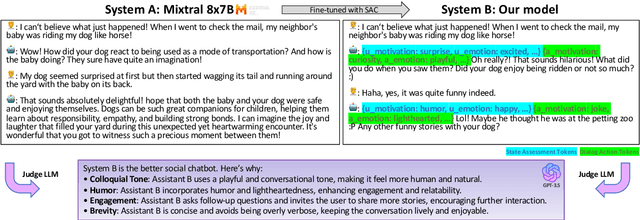
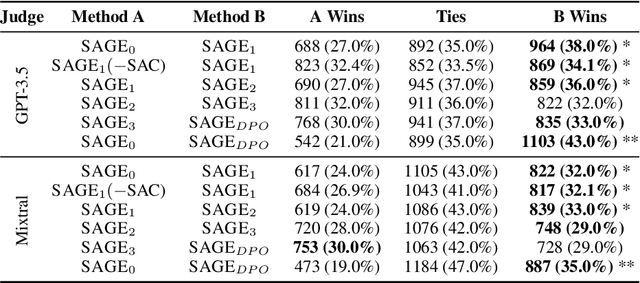
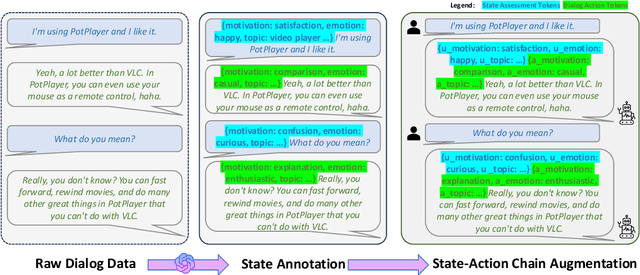

Abstract:Recent advances in large language models have demonstrated impressive capabilities in task-oriented applications, yet building emotionally intelligent chatbots that can engage in natural, strategic conversations remains a challenge. We present a novel approach called SAGE that uses latent variables to control long-horizon behavior in dialogue generation. At the core of our method is the State-Action Chain (SAC), which augments standard language model fine-tuning by introducing latent variables that encapsulate emotional states and conversational strategies between dialogue turns. During inference, these variables are generated before each response, enabling coarse-grained control over dialogue progression while maintaining natural interaction patterns. We also introduce a self-improvement pipeline that leverages dialogue tree search, LLM-based reward modeling, and targeted fine-tuning to optimize conversational trajectories. Our experimental results show that models trained with this approach demonstrate improved performance in emotional intelligence metrics while maintaining strong capabilities on LLM benchmarks. The discrete nature of our latent variables facilitates search-based strategies and provides a foundation for future applications of reinforcement learning to dialogue systems, where learning can occur at the state level rather than the token level.
Reversal Blessing: Thinking Backward May Outpace Thinking Forward in Multi-choice Questions
Feb 25, 2025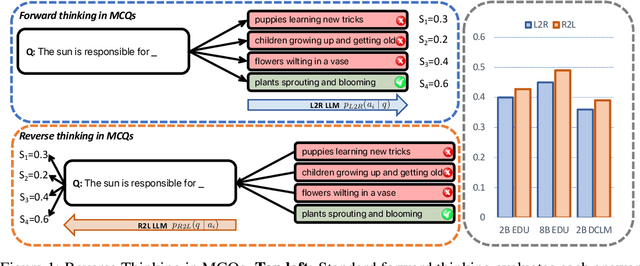
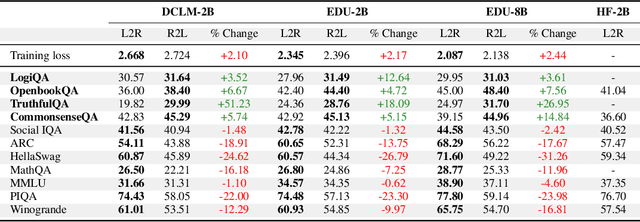

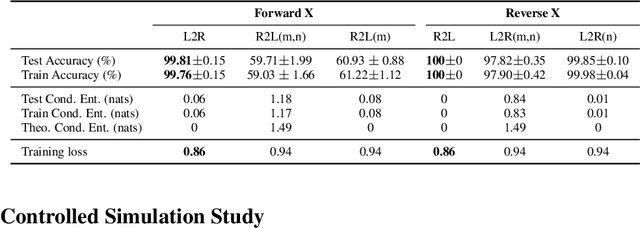
Abstract:Language models usually use left-to-right (L2R) autoregressive factorization. However, L2R factorization may not always be the best inductive bias. Therefore, we investigate whether alternative factorizations of the text distribution could be beneficial in some tasks. We investigate right-to-left (R2L) training as a compelling alternative, focusing on multiple-choice questions (MCQs) as a test bed for knowledge extraction and reasoning. Through extensive experiments across various model sizes (2B-8B parameters) and training datasets, we find that R2L models can significantly outperform L2R models on several MCQ benchmarks, including logical reasoning, commonsense understanding, and truthfulness assessment tasks. Our analysis reveals that this performance difference may be fundamentally linked to multiple factors including calibration, computability and directional conditional entropy. We ablate the impact of these factors through controlled simulation studies using arithmetic tasks, where the impacting factors can be better disentangled. Our work demonstrates that exploring alternative factorizations of the text distribution can lead to improvements in LLM capabilities and provides theoretical insights into optimal factorization towards approximating human language distribution, and when each reasoning order might be more advantageous.
Eliciting In-context Retrieval and Reasoning for Long-context Large Language Models
Jan 14, 2025
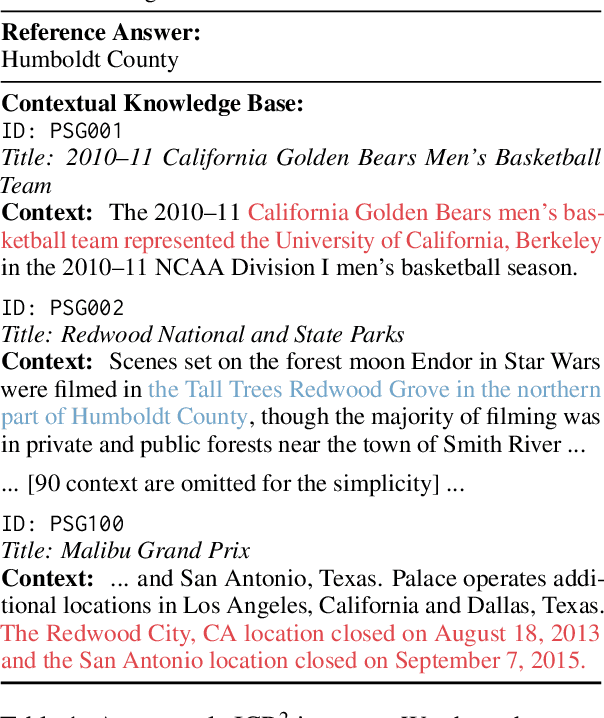
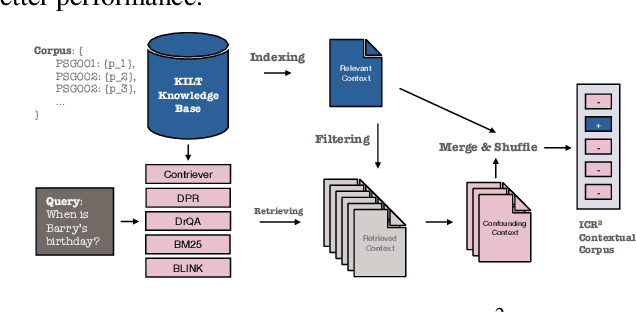
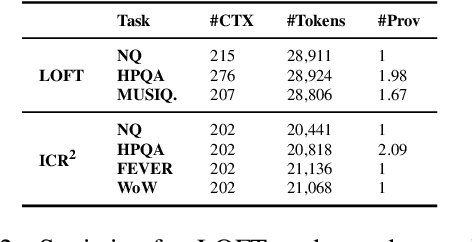
Abstract:Recent advancements in long-context language models (LCLMs) promise to transform Retrieval-Augmented Generation (RAG) by simplifying pipelines. With their expanded context windows, LCLMs can process entire knowledge bases and perform retrieval and reasoning directly -- a capability we define as In-Context Retrieval and Reasoning (ICR^2). However, existing benchmarks like LOFT often overestimate LCLM performance by providing overly simplified contexts. To address this, we introduce ICR^2, a benchmark that evaluates LCLMs in more realistic scenarios by including confounding passages retrieved with strong retrievers. We then propose three methods to enhance LCLM performance: (1) retrieve-then-generate fine-tuning, (2) retrieval-attention-probing, which uses attention heads to filter and de-noise long contexts during decoding, and (3) joint retrieval head training alongside the generation head. Our evaluation of five well-known LCLMs on LOFT and ICR^2 demonstrates significant gains with our best approach applied to Mistral-7B: +17 and +15 points by Exact Match on LOFT, and +13 and +2 points on ICR^2, compared to vanilla RAG and supervised fine-tuning, respectively. It even outperforms GPT-4-Turbo on most tasks despite being a much smaller model.
Training Software Engineering Agents and Verifiers with SWE-Gym
Dec 30, 2024



Abstract:We present SWE-Gym, the first environment for training real-world software engineering (SWE) agents. SWE-Gym contains 2,438 real-world Python task instances, each comprising a codebase with an executable runtime environment, unit tests, and a task specified in natural language. We use SWE-Gym to train language model based SWE agents , achieving up to 19% absolute gains in resolve rate on the popular SWE-Bench Verified and Lite test sets. We also experiment with inference-time scaling through verifiers trained on agent trajectories sampled from SWE-Gym. When combined with our fine-tuned SWE agents, we achieve 32.0% and 26.0% on SWE-Bench Verified and Lite, respectively, reflecting a new state-of-the-art for open-weight SWE agents. To facilitate further research, we publicly release SWE-Gym, models, and agent trajectories.
Normalizing Flows are Capable Generative Models
Dec 10, 2024Abstract:Normalizing Flows (NFs) are likelihood-based models for continuous inputs. They have demonstrated promising results on both density estimation and generative modeling tasks, but have received relatively little attention in recent years. In this work, we demonstrate that NFs are more powerful than previously believed. We present TarFlow: a simple and scalable architecture that enables highly performant NF models. TarFlow can be thought of as a Transformer-based variant of Masked Autoregressive Flows (MAFs): it consists of a stack of autoregressive Transformer blocks on image patches, alternating the autoregression direction between layers. TarFlow is straightforward to train end-to-end, and capable of directly modeling and generating pixels. We also propose three key techniques to improve sample quality: Gaussian noise augmentation during training, a post training denoising procedure, and an effective guidance method for both class-conditional and unconditional settings. Putting these together, TarFlow sets new state-of-the-art results on likelihood estimation for images, beating the previous best methods by a large margin, and generates samples with quality and diversity comparable to diffusion models, for the first time with a stand-alone NF model. We make our code available at https://github.com/apple/ml-tarflow.
Visatronic: A Multimodal Decoder-Only Model for Speech Synthesis
Nov 26, 2024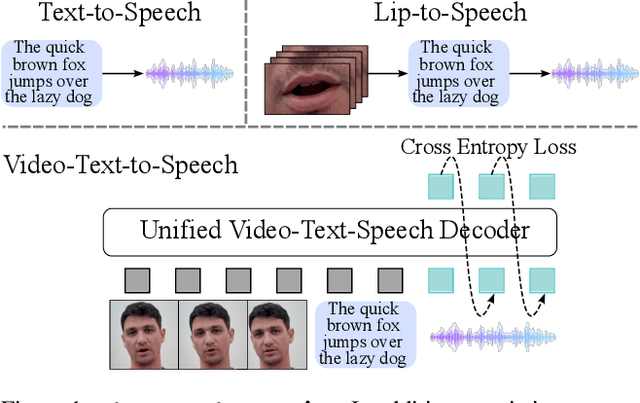



Abstract:In this paper, we propose a new task -- generating speech from videos of people and their transcripts (VTTS) -- to motivate new techniques for multimodal speech generation. This task generalizes the task of generating speech from cropped lip videos, and is also more complicated than the task of generating generic audio clips (e.g., dog barking) from videos and text. Multilingual versions of the task could lead to new techniques for cross-lingual dubbing. We also present a decoder-only multimodal model for this task, which we call Visatronic. This model embeds vision, text and speech directly into the common subspace of a transformer model and uses an autoregressive loss to learn a generative model of discretized mel-spectrograms conditioned on speaker videos and transcripts of their speech. By embedding all modalities into a common subspace, Visatronic can achieve improved results over models that use only text or video as input. Further, it presents a much simpler approach for multimodal speech generation compared to prevailing approaches which rely on lip-detectors and complicated architectures to fuse modalities while producing better results. Since the model is flexible enough to accommodate different ways of ordering inputs as a sequence, we carefully explore different strategies to better understand the best way to propagate information to the generative steps. To facilitate further research on VTTS, we will release (i) our code, (ii) clean transcriptions for the large-scale VoxCeleb2 dataset, and (iii) a standardized evaluation protocol for VTTS incorporating both objective and subjective metrics.
 Add to Chrome
Add to Chrome Add to Firefox
Add to Firefox Add to Edge
Add to Edge